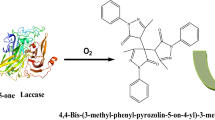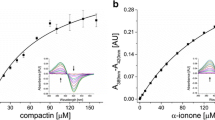Abstract
The plant originated stilbene “resveratrol” (3,4′,5-trans-trihydroxystilbene) is well known for its diverse health benefits including anti-tumor, anti-inflammatory, anti-microbial, and anti-oxidant properties. Besides a significant amount of reports on different aspects of its application as prodrug in the last 50 years, still, a strategy leading to the production of the active drug is missing. The aim of this work was to evaluate the enzymatic activation of prodrug resveratrol to the effective drug piceatannol, without engaging expensive cofactors. Five different heme proteins were analyzed for the transformation of resveratrol. Kinetic parameters of resveratrol transformation and analysis of the transformed products were conducted through HPLC and GC-MS. Effect of pH and organic solvent on the transformation process had also been evaluated. Among all tested heme proteins, only a variant of cytochrome P450BM3 from Bacillus megaterium (CYPBM3F87A) was found suitable for piceatannol production. The most suitable pH for the reaction conditions was 8.5, while organic solvents did not show any effect on transformation. For resveratrol transformation, the turnover rate (k cat) was 21.7 (± 0.6) min−1, the affinity constant (K M) showed a value of 55.7 (± 16.7) μM for a catalytic efficiency (k cat/K M) of 389 min−1 mM−1. GC-MS analysis showed that the only product from resveratrol transformation by cytochrome P450BM3 is the biologically active piceatannol. The enzymatic transformation of resveratrol, an emerging compound with medical interest, to active product piceatannol by a variant of cytochrome P450BM3 in the absence of expensive NADPH cofactor is demonstrated. This enzymatic process is economically attractive and can be scaled up to cover the increasing medical demand for piceatannol.




Similar content being viewed by others
References
Piotrowska, H., Kucinska, M., & Murias, M. (2012). Biological activity of piceatannol: leaving the shadow of resveratrol. Mutation Research, 750(1), 60–82.
Cordova-Gomez, M., Galano, A., & Alvarez-Idaboy, J. A. (2013). Piceatannol, a better peroxyl radical scavenger than resveratrol. RSC Advances, 3(43), 20209–20218.
Kiselev, K. V. (2011). Perspectives for production and application of resveratrol. Applied Microbiology and Biotechnology, 90(2), 417–425.
Kukreja, A., Wadhwa, N., & Tiwari, A. (2014). Therapeutic role of resveratrol and piceatannol in disease prevention. Journal of Blood Disorder and Transfusion, 5(9), 1–6.
Potter, G. A., Patterson, L. H., Wanogho, E., Perry, P. J., Butler, P. C., Ijaz, T., Ruparelia, K. C., Lamb, J. H., Farmer, P. B., Stanley, L. A., & Burke, M. D. (2002). The cancer preventative agent resveratrol is converted to the anticancer agent piceatannol by the cytochrome P450 enzyme CYP1B1. Brazilian Journal of Cancer, 86(5), 774–778.
Piver, B., Fer, M., Vitrac, X., Merillon, J. M., Dreano, Y., Berthou, F., & Lucas, D. (2004). Involvement of cytochrome P450 1A2 in the biotransformation of trans-resveratrol in human liver microsomes. Biochemical Pharmacology, 68(4), 773–782.
Agundez, J. A. (2004). Cytochrome P450 gene polymorphism and cancer. Current Drug Metabolism, 5(3), 211–224.
Choudharya, D., Janssona, I., Schenkmana, J. B., Sarfarazib, M., & Stoilovb, I. (2003). Comparative expression profiling of 40 mouse cytochrome P450 genes in embryonic and adult tissues. Archives of Biochemistry and Biophysics, 414(1), 91–100.
Kramer, S. D., & Testa, B. (2008). The biochemistry of drug metabolism–an introduction: part 6. Inter-individual factors affecting drug metabolism. Chemistry and Biodiversity, 5(12), 2465–2578.
Testa, B. (2009). Prodrugs: bridging pharmacodynamic/pharmacokinetic gaps. Current Opinion in Chemical Biology, 13(3), 338–344.
Huttunen, K. M., Raunio, H., & Rautio, J. (2011). Prodrugs—sfrom serendipity to rational design. Pharmacological Reviews, 63(3), 750–771.
Otey, C. R., Bandara, G., Lalonde, J., Takahashi, K., & Arnold, F. (2005). Preparation of human metabolites of propranolol using laboratory-evolved bacterial cytochrome P450. Biotechnology and Bioengineering, 93(3), 494–499.
Yun, H., Kim, K. H., Kim, D. H., Jung, H. C., & Pan, J. G. (2007). The bacterial P450 BM3: a prototype for a biocatalyst with human P450 activities. Trends in Biotechnology, 25(7), 289–298.
Kim, D. H., Ahn, T., Jung, H. C., Pan, J. G., & Yun, C. H. (2009). Generation of the human metabolite piceatannol from the anticancer-preventive agent resveratrol by bacterial cytochrome P450 BM3. Drug Metabolism and Disposition, 37(5), 932–936.
Quester, K., Juarez-Moreno, K., Secundino, I., Roseinstein, Y., Alejo, K. P., Huerta-Saquero, A., & Vazquez-Duhalt, R. (2017). Cytochrome P450 bioconjugate as a nanovehicle for improved chemotherapy treatment. Macromolecular Bioscience, 17(5), 1600374.
Ayala, M., Hernandez-Lopez, E., Perezgasga, L., & Vazquez-Duhalt, R. (2012). Reduced coke formation and aromaticity due to chloroperoxidase-catalyzed transformation of asphaltenes from Maya crude oil. Fuel, 92(1), 245–249.
Baratto, M. C., Juarez-Moreno, K., Pogni, R., Basosi, R., & Vazquez-Duhalt, R. (2015). EPR and LC-MS studies on the mechanism of industrial dye decolorization by versatile peroxidase from Bjerkandera adusta. Environmental Science and Pollution Research, 22(11), 8683–8692.
Uyuama, H., & Kobayashi, S. (2003). Enzymatic synthesis of polyphenols. Current Organic Chemistry, 7(13), 1387–1397.
Wagner, M., & Nicell, J. A. (2002). Detoxification of phenolic solutions with horseradish peroxidase and hydrogen peroxide. Water Research, 36(16), 4041–4052.
Vidal-Limón, A., Águila, S., Ayala, M., Batista, C. V., & Vazquez-Duhalt, R. (2013). Peroxidase activity stabilization of cytochrome P450BM3 by rational analysis of intramolecular electron transfer. Journal of Inorganic Biochemistry, 122(1), 18–26.
Cirino, P. C., & Arnold, F. H. (2002). Regioselectivity and activity of cytochrome P450 BM-3 and mutant F87A in reactions driven by hydrogen peroxide. Advanced Synthesis and Catalysis, 344(9), 932–937.
Sanchez-Sanchez, L., Roman, R., & Vazquez-Duhalt, R. (2012). Pesticide transformation by a variant of CYPBM3 with improved peroxygenase activity. Pesticide Biochemistry and Physiology, 102(2), 169–174.
Auclair, K., Moënne-Loccoz, P., & Ortiz de Montellano, P. R. (2001). Roles of the proximal heme thiolate ligand in cytochrome P450cam. Journal of the American Chemical Society, 123(21), 4877–4885.
Yoshioka, S., Takahashi, S., Ishimori, K., & Morishima, I. (2000). Roles of the axial push effect in cytochrome P450cam studied with the site-directed mutagenesis at the heme proximal site. Journal of Inorganic Biochemistry, 81(3), 141–151.
Klibanov, A. M. (2001). Improving enzymes by using them in organic solvents. Nature, 409, 241–246.
Ravichandran, K. G., Boddupalli, S. S., Hasemann, C. A., Peterson, J. A., & Deisenhofer, J. (1993). Crystal structure of hemoprotein domain of P450BM-3, a prototype for microsomal P450’s. Science, 261, 731–736.
Torres, E., Siminovich, B., Barzana, E., & Vazquez-Duhalt, R. (1998). Thermodynamic hydrophobicity of aqueous mixtures of water-miscible organic solvents predicts peroxidase activity. Journal of Molecular Catalysis B: Enzymatic, 4(3), 155–159.
Acknowledgements
We are grateful to DGAPA-UNAM program providing postdoctoral fellowship to R.K. We also thank Dr. Katrin Quester for her excellent technical assistance throughout the study.
Funding
This work has been funded by the National Council of Science and Technology (CONACYT), (grants IFC 2015-1 and SEP-CONACYT-251241).
Author information
Authors and Affiliations
Corresponding author
Ethics declarations
Conflict of Interest
The authors declare that they have no conflict of interest.
Rights and permissions
About this article
Cite this article
Koyani, R.D., Vazquez-Duhalt, R. Enzymatic Activation of the Emerging Drug Resveratrol. Appl Biochem Biotechnol 185, 248–256 (2018). https://doi.org/10.1007/s12010-017-2645-7
Received:
Accepted:
Published:
Issue Date:
DOI: https://doi.org/10.1007/s12010-017-2645-7




